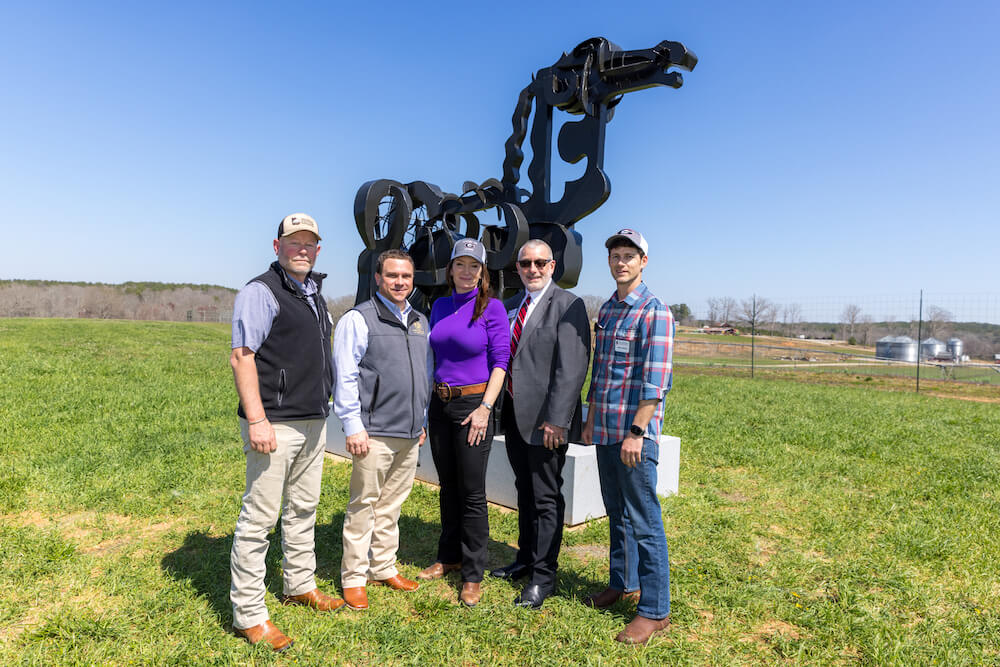
Takeaways
- H.R. 1 functions as a modified Farm Bill, keeping core agricultural and nutrition programs in place while making major budget and policy changes across several of them, including adjustments to SNAP eligibility and requirements.
- Georgia producers see shifts in safety net programs, with higher reference prices for peanuts and cotton, continued federal crop insurance support and the creation of a first-time insurance option for poultry operations.
- The law pairs short-term support with long-term planning, maintaining income-stabilizing programs now while expanding trade promotion and global market development in the future.
Whether or not you follow politics, policies passed in Washington, D.C., shape nearly every part of daily life in the U.S., from how our food is grown to how it reaches our tables.
Among the largest and most wide-reaching pieces of legislation is the Farm Bill, an omnibus law that governs the nation’s agricultural production and nutrition programs. Passed roughly every five years, the Farm Bill covers 11 major areas, or “titles,” including crop insurance, conservation, nutrition assistance and agricultural research.
The most recent version, enacted in 2018, was extended twice and set to expire this September. In the meantime, U.S. producers have faced a mix of challenges from extreme weather events, global supply chain disruptions lingering from the COVID-19 pandemic, trade wars and the ongoing pressures of globalization.
In a departure from tradition, Congress this summer signed into law House Resolution 1 (H.R. 1), a sweeping measure that folded many elements of a typical Farm Bill into a broader legislative package covering a wide range of budget and policy changes. While H.R. 1 kept many core Farm Bill programs intact, it also set the stage for how U.S. agriculture will operate in the near future, blending short-term relief with longer-term strategies for global market development.
A new Farm Bill by another name
According to Ford Ramsey, an associate professor in the Department of Agricultural and Applied Economics at the University of Georgia, the agriculture-related components of H.R. 1 function much like a traditional Farm Bill.

“If you look at where most Farm Bill dollars go, such as nutrition programs, federal crop insurance and commodity programs — those core pieces are in H.R. 1,” said Ramsey, faculty in the College of Agricultural and Environmental Sciences (CAES). “So, functionally, it acts like a Farm Bill.”
The 2018 Farm Bill expired in in 2023, and Congress since passed multiple extensions of the current law while competing versions of a new bill stalled in both the House and Senate. With Republicans retaking the Senate and the White House after the 2024 election, this set up the potential for the majority party in Congress to pass legislation via the budget reconciliation process, a procedure that is often used when one party controls both the executive and legislative branches. Reconciliation is an expedited legislative process that allows for changes to measures that impact spending and revenues to be passed with a simple majority vote in the Senate, rather than the usual 60-vote threshold for passage. As Congress considered and passed a reconciliation bill, H.R. 1, this summer, a decision was made to insert certain Farm Bill programs into the bill.
On the nutrition side, the Supplemental Nutrition Assistance Program (SNAP) remains in place, although work requirements have become more stringent. Ramsey explained that SNAP was historically included in the Farm Bill to help unite urban and rural lawmakers, where nutrition assistance helped address food insecurity issues in more populated areas and agricultural support for farming communities in rural areas. The alliance has weakened over the past decade, he said, making bipartisan support for the massive legislation increasingly difficult to achieve.
How the bill helps farmers stay afloat
For Georgia farmers, H.R. 1 provides a blend of financial support and stability through programs that work much like insurance. Two of the most important are Agricultural Risk Coverage (ARC) and Price Loss Coverage (PLC).
ARC helps farmers when their total revenue — the combination of prices and yields — falls below a set average. PLC kicks in when market prices drop below a guaranteed reference price for a specific crop. When that happens, the federal government helps make up the difference.
“When prices fall or yields are poor, these programs help farmers stay in business,” Ramsey said. “Peanuts and cotton are the big winners in Georgia because their reference prices were raised in this bill.”
Another major piece is the federal crop insurance program, which helps protect producers from losses due to weather, pests or disease. Farmers pay premiums, but those premiums are heavily subsidized, making coverage affordable enough that most large-acreage crops, like cotton, corn, soybeans and peanuts, are insured every year.
Preparing for storms and market shocks
For Georgia’s poultry industry, H.R. 1 directs the U.S. Department of Agriculture to create an insurance program for poultry operations, the first of its kind for the state’s top agricultural commodity, which brings in $6.93 billion annually to the state’s economy.
The coverage will likely function like disaster insurance, providing payments when hurricanes or high winds strike poultry-producing counties. The industry suffered devastating losses from Hurricane Helene in late September 2023, totaling $683 million, and producers are still working to recover and rebuild.

Meanwhile, fruit and vegetable growers remain more vulnerable, Ramsey explained. These specialty crops don’t always qualify for the same protections that larger row crops receive. Some have access to limited catastrophic coverage, but payouts rarely match the true cost of losses. It’s a highly labor-intensive industry that faces stiff competition from countries with more favorable growing conditions and looser labor regulations, all while domestic growers continue to grapple with worker shortages and the challenges of the H-2A guest worker program.
“What these specialty crop growers want is protection when prices drop, even in good weather years,” said Gopi Munisamy, Distinguished Professor of Agricultural Marketing at CAES. “That could come later in a smaller follow-up bill.”
The global picture of the law
Munisamy said the new law also introduces a two-stage strategy for agriculture: short-term income support now and long-term market expansion later. Beginning in 2027, a new trade promotion program, roughly equal in size to the long-standing Market Access and Foreign Market Development programs combined, will double the funds available for building new export markets.
“It’s designed to stabilize incomes for a few years, then ramp up international demand for U.S. products,” Munisamy explained.
But he cautioned that markets aren’t rebuilt by money alone. With the rules-based structure of the World Trade Organization weakening, countries often respond to U.S. policy changes through what he calls “silent retaliation.”
An example is China redirecting soybean and cotton purchases to Brazil. “Nobody announces it,” Munisamy said, “they just stop ordering.”
“Money for advertisements can’t replace trust. We must re-engage trading partners. And while the short-term support keeps farms afloat and long-term investments build demand, diplomacy is what really opens markets,” he added.
Why farm policy matters at home
While grocery prices have climbed steadily in recent years, those increases are largely tied to broader economic forces from inflation and energy costs to global supply chain disruptions, rather than changes in farm policy, said Munisamy.
Related Content
“That means even big changes in farm policy don’t move grocery prices much, so consumers won’t see much difference at the store, but producers feel it directly,” he said.
He explained that if you spend $1 at the grocery store, only about 8 cents of that dollar goes back to the farmer who produced the food. Two decades ago, it was closer to 14 cents. The rest is divided among processing, packaging, transportation, energy, marketing and retail costs, according to the U.S. Department of Agriculture’s Economic Research Service.
“So, while the average shopper may not notice a difference on their grocery receipt, the ripple effects through rural communities are significant,” Ramsey said. “Any money that goes into farms circulates locally. It supports gins, processors, feed stores and equipment suppliers. If a farm sector collapses, those businesses and jobs are hit first.”
That economic stability is what programs like crop insurance and price supports are designed to protect, he added. Many small and midsized farms in Georgia rely on off-farm income to make ends meet, so these federal programs help balance bad years with good ones and keep family farms operating — which affects everyone, whether you live in a farming community or not.
Farm policy 101: Understanding the agriculture “safety net”
Together, the following programs form the backbone of U.S. farm policy. They stabilize farm incomes, prevent widespread bankruptcies after disasters, and help keep food production — and prices — relatively steady for consumers.
Agricultural Risk Coverage (ARC)
ARC helps farmers when their total revenue — the combination of crop prices and yields — drops below a long-term average. It acts as protection against a tough season when bad weather or lower prices reduce income.
Price Loss Coverage (PLC)
PLC protects farmers when market prices fall below a set “reference price.” The program covers part of that gap, helping producers manage price swings in global markets. The reference price functions like a floor — if prices drop beneath it, the program helps farmers stay solvent.
Federal Crop Insurance
Federal crop insurance works like insurance for disaster losses or unpredictable weather. Farmers pay premiums, but they’re heavily subsidized, making coverage accessible. When droughts, floods or hurricanes damage crops, payouts help keep operations running until the next season.
What’s next in agricultural policy
For decades, Congress has renewed the farm bill about every five years, setting a single timeline for dozens of farm and nutrition programs. With the passage of H.R. 1, this year looks different.
H.R. 1 doesn’t follow that same five-year pattern. Each part of the law has its own expiration date, meaning lawmakers will revisit policies on different schedules.
To keep certain programs running that weren’t included in H.R. 1, Congress passed what’s called a continuing resolution, or CR — a short-term funding measure that extends those programs through Sept. 30, 2026, giving lawmakers additional time to consider agricultural policy moving forward.
Both economists hope lawmakers will eventually return to the regular Farm Bill cycle. Until then, H.R. 1 and CR act as a bridge for the farm economy while the next round of policy takes shape.



